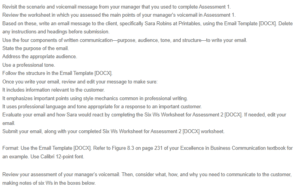Active Listening – The Six Ws
| Who are you writing to? | Sara Robins at Printables |
| What is the problem? | Sara Robins at Printables ordered a shipment from ABC Inc. more than a week ago but she has not yet received the shipment or any communication from the company about the shipment. |
| What are your responsibilities to solve the problem? What responsibilities do others in your organization have? | One of my responsibilities is to apologize to the client for the inconvenience caused by the company. My second responsibility is to inform the client that the company is taking necessary measures to ensure that the issue is resolved within the shortest time possible. My third responsibility is to ensure that the company issues a shipping refund and delivers the shipment by Thursday.
The responsibilities that others in the organizations have include delivering the shipment by Thursday and issuing a refund for the shipping charge. |
| When will the problem be corrected? | The problem will be corrected right away. |
| How will the problem be addressed? What are the steps involved? | The problem will be corrected by delivering the shipment to Sara Robins by Thursday and refunding the shipping costs.
One of the steps involved in addressing the problem is explaining the situation to Sara Robins. The second step is refunding the shipping costs. The third step is delivering the shipment. |
|
Why are you sending the customer a message? |
I am sending the customer a message to explain the situation and apologize for the inconvenience caused by ABC Inc. |
In addition, consider the following:
| How do you think your customer is feeling? | The client is feeling disappointed. |
| Why do you think your customer is feeling that way? | The customer is feeling disappointed because the company did not communicate about delays in the shipment delivery despite receiving the order and the payment for shipping costs. |
| What are you trying to accomplish in the email you are sending? In other words, what is your purpose for writing? | I am trying to regain a good relationship between the client and the company in the email I am sending by assuring the client that the company is sorry for the current mistake and that it will never happen again so that the company does not lose the client. |
ORDER A PLAGIARISM-FREE PAPER HERE
We’ll write everything from scratch
Question

Active Listening – The Six Ws
Revisit the scenario and voicemail message from your manager that you used to complete Assessment 1.
Review the worksheet in which you assessed the main points of your manager’s voicemail in Assessment 1.
Based on these, write an email message to the client, specifically Sara Robins at Printables, using the Email Template [DOCX]. Delete any instructions and headings before submission.
Use the four components of written communication—purpose, audience, tone, and structure—to write your email.
State the purpose of the email.
Address the appropriate audience.
Use a professional tone.
Follow the structure in the Email Template [DOCX].
Once you write your email, review and edit your message to make sure:
It includes information relevant to the customer.
It emphasizes important points using style mechanics common in professional writing.
It uses professional language and tone appropriate for a response to an important customer.
Evaluate your email and how Sara would react by completing the Six Ws Worksheet for Assessment 2 [DOCX]. If needed, edit your email.
Submit your email, along with your completed Six Ws Worksheet for Assessment 2 [DOCX] worksheet.
Format: Use the Email Template [DOCX]. Refer to Figure 8.3 on page 231 of your Excellence in Business Communication textbook for an example. Use Calibri 12-point font.
Review your assessment of your manager’s voicemail. Then, consider what, how, and why you need to communicate to the customer, making notes of six Ws in the boxes below.
| Who are you writing to? | |
| What is the problem? | |
| What are your responsibilities to solve the problem? What responsibilities do others in your organization have? | |
| When will the problem be corrected? | |
| How will the problem be addressed? What are the steps involved? | |
| Why are you sending the customer a message? |
In addition, consider the following:
| How do you think your customer is feeling? | |
| Why do you think your customer is feeling that way? | |
| What are you trying to accomplish in the email you are sending? In other words, what is your purpose for writing? |

